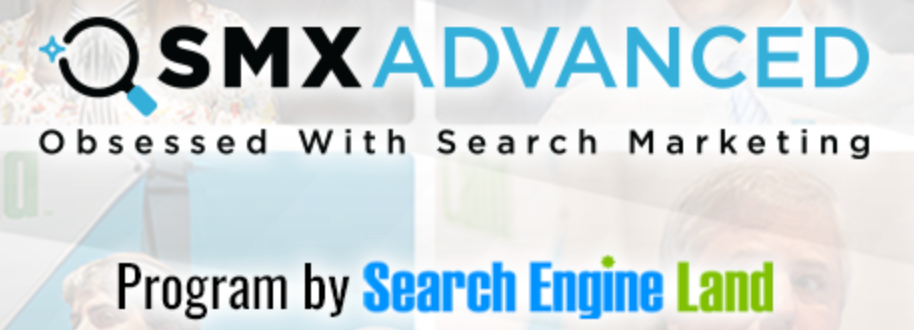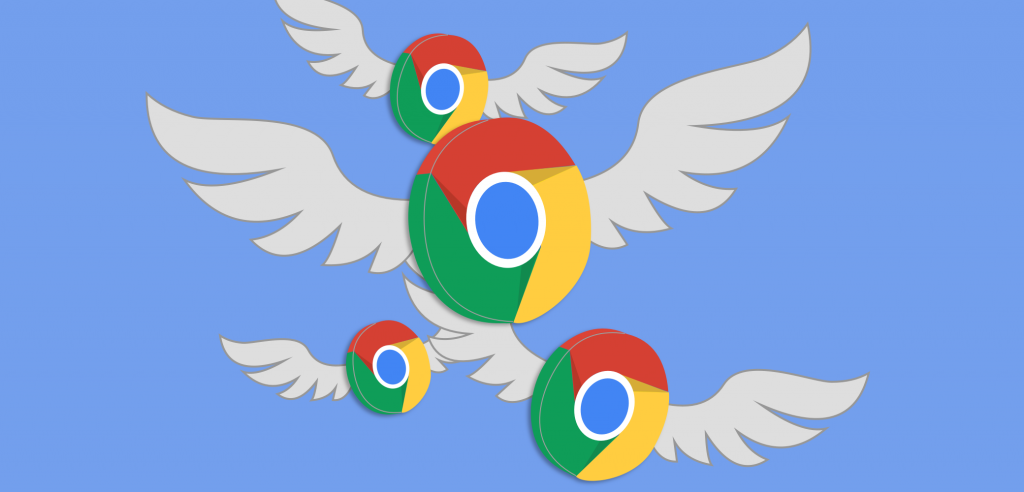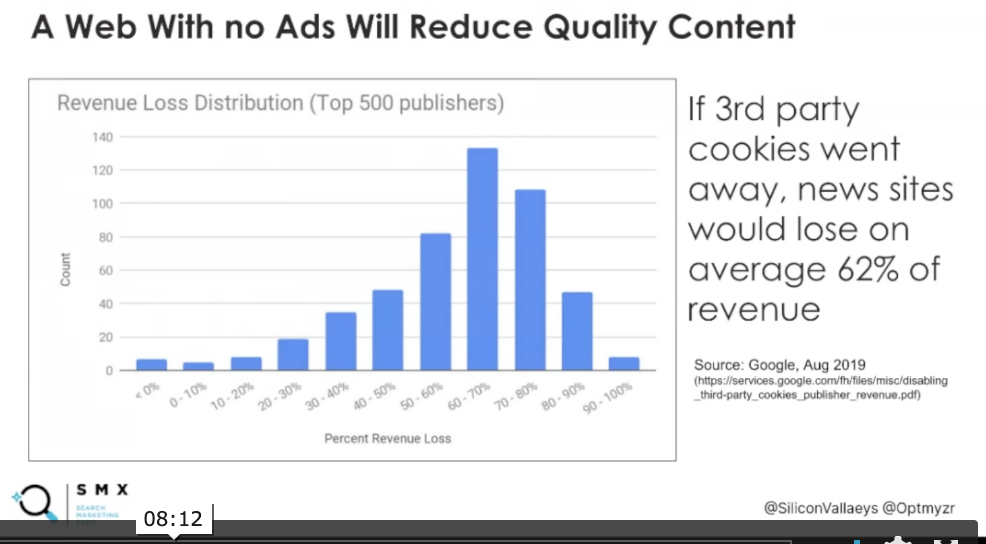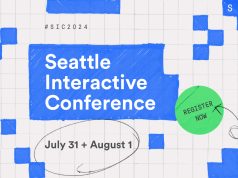For the past 14 years in a row, birds of a feather in SEO and PPC have flocked together around the Seattle waterfront to participate in SMX Advanced, the most forward-thinking Search Marketing Expo of its kind.
This year, the event went virtual for the first time ever, but the “birds were on the wire,” and no less enthralled with the impressive plumage of the world-class presenters. The online format offered many distinct advantages — on-demand session viewing and replays, downloads of supporting materials, and simultaneous online chat for live Q&A before, during and after the sessions.
One of the red-hot topics at this year’s Expo was Google’s announcement that it will replace the use of 3rd-Party Cookies as advertising trackers with its own, open source, privacy solution.
The movement among tech companies including Apple, Microsoft, and Google to “self-police” their privacy practices, and keep the government at bay, has been met with equal parts optimism and skepticism. With regulators looming, the tech world has every incentive to make a self-imposed solution work.
Google’s Privacy Sandbox initiative has christened a prototype named FLoC which stands for Federated Learning of Cohorts. The Cohorts are you and me, only as part of a large group and treated anonymously, provided we share some of the same interests.
FLoC is a method for affinity groups to be chosen and delivered personalized, interest-based advertising based on data in your Web browser , not in the Cloud. The system works by gathering data about a user’s browsing habits and then comparing that with groups of other users of similar interests — the Cohorts. The algorithm used to corral Cohorts can look at the URLs of sites that the user visited and the content of those pages, among other factors, according to the FLoC proposal. Information about each Cohort group can then be shared for advertising purposes while user anonymity is preserved. The browser exposes the Cohort ID, not the user’s identity.
In theory, Cohorts are groups of sufficient size that it is difficult if not impossible to identify any particular individual within a group. But the Cohort’s profile as a group can also be specific enough to enable effective ad targeting. The system is also dynamic. Users are assigned into new Cohorts on a weekly basis, based on their previous week’s browsing data.
FLoC is rolling out exclusively on Google’s Chrome browser and Google has already started testing FLoC-based cohorts with advertisers.
We caught up with Frederick Vallaeys (@SiliconVallaeys), the cofounder and CEO of Optmyzr and the author of Digital Marketing in an AI World. Fred worked at Google during a period one might call AdWords Golden Age, the decade from 2002-2012, and was one of Google’s earliest AdWords evangelists. He has not lost his pro-advertising zeal nor his talent for explaining complex topics and elevating our knowledge like the wind beneath our wings. Here’s how we birds may soon FLoC together, how FLoC is truly different, and the difference it can make!
Seattle24x7: Welcome to Seattle in the Cloud, Fred. Tell us, how would you synthesize the mission of Google’s FLoC initiative?
Vallaeys: What we are talking about when we talk about FLoC is a proposal of new ways that browsers can enable Internet-based advertising on the Web in a privacy-sensitive manner.
Let’s survey the landscape. In pay-per-click advertising we are very used to four key ways of targeting our ads.
The first is Keywords which are very “intent-driven.” This is what Google AdWords was founded on. Keywords bridge the gap between what the user is searching for and what the advertiser is providing. The power of keywords remains in the new search privacy initiative.
Contextual advertising, the second method, is also not going to change much. This is looking at what the user is reading on a page, and how ads can be shown that are related to that content.
What will change is how we think about Audiences. It’s not about what the user is looking at here and now, but historically — what have they been interested in, what kind of sites do they typically visit, where do they hang out on the Web?
Number four is Remarketing. Users have come to your site before. Now they are doing other things on the Web. You can follow them and make them more offers to try and win them back to your Website, and what it is that you have to offer. This will change in new and exciting ways.
Seattle24x7: You contend that the latter two methods, Audience and Remarketing are being remade?
Vallaeys: Right, these methods are essentially in transition. Over the last decade, the Web has had a push to grater privacy. In 2016, the European Union and the state of California, among other bodies, started putting in place new mechanisms for data protection. Things like General Data Protection Regulation or GDPR, and the California Consumer Privacy Act or CCPA. These are government regulations to make the Web more private, to inform users what is happening with their data.
Not surprisingly, the Web’s tech companies do not like being regulated. They want to prove they can self-regulate.
Seattle24x7: Companies like Apple, for instance?
Vallaeys: Apple is a great example of this. In the last year, Apple introduced intelligent tracking prevention (ITP) in the Safari Web browser. There is a little shield at the top of the Safari page that reports “We just blocked 37 third-party trackers.” Firefox does the same thing. These companies have made proactive decisions to police privacy. What is interesting is that neither of these companies have a very big advertising business. They are fine with saying good riddance to third-party cookies.
On the other hand, marketers know that relevant advertising is powerful. It’s what users want. It’s what helps businesses to grow, so companies like Google who do have a stake in advertising wanted to come up with an actual solution. Rather than just cut out third-party cookies, they needed rot come up with an alternative that lets marketers target advertising but in a way hat makes its private.
Seattle24x7: Say hello to FLoC?
FLoC is Google’s answer. Parakeet is the privacy proposal from Microsoft. Turtledove and Fledge are other Google proposals specifically to do with Remarketing.
Google has said that its Chrome browser will not turn off third-party cookies until some of these solutions have been fully developed.
Seattle24x7: There are still many open issues?
Vallaeys: Correct. How to deal with authentication, validation of the ads being served, denial of service attacks, click fraud prevention — all of these things still need to be figured out.
Seattle24x7: You remain an evangelist for the power of advertising?
Vallaeys: The reason that this is such an important discussion is that the magic of the Web, the thing that makes the Web work in my opinion, is advertising. We all love going onto the Internet and finding this incredible variety of sources: entertainment, things to read, explainer articles. The Web is super useful, and the reason is that it is supported by advertising. Advertising makes the Internet possible.
When you take away the advertisers’ ability to target ads and get new customers, many Websites can no longer be monetized and they will either close down or put up a Paywall; That creates an affordability issue. Some people will be able to afford paid content and a whole other group of people will no longer have access. Great content on the Web breaks down if we don’t solve the advertising issue.
Seattle24x7: The economics of Web advertising have clearly disrupted or even transformed many industries?
Vallaeys: One particular study looked at what happens to news organizations when you remove third-party cookies. The results were pretty dramatic. 62% of revenue, on average, would be lost. We know that news organizations are struggling as it is. Taking away another 62% of revenue is very meaningful. We may lose access to free news. That’s a very big deal.
Seattle24x7: How has ad serving come to depend on private data?Vallaeys: In the current model, a user opens their browser and loads up a Web page. The Web page sees the arrival of the user and wants to show them an ad. So it connects with the ad network. The ad network looks at which advertisers are willing to show an ad. The way they are able to attract advertisers is by demonstrating that the visitor has a propensity to buy their product or service. The ad network has profiles of individual users. They don’t necessarily know them as individuals but as individual “cookies.” That has been what enables the Web to be monetized and the Web to be free.
Seattle24x7: So Google has introduced its Privacy Sandbox.
Vallaeys: The Privacy Sandbox is, according to Google, “a set of open standards to fundamentally enhance privacy on the web. Our goal for this open source initiative is to make the web more private and secure tor users while also supporting publishers.” While Google and Chrome are early movers, the sandbox is an open-source Web standard that is being tested in Chrome. Any browser can implement the standard.
With FLoC, instead of the user being understood by their cookie ID, the user will be anonymized as a Cohort. This is happening, not in the Cloud, but in the local Web browser on your machine. In turn, the browser is sharing that information back to the ad network. The user becomes part of a larger group where, in that group they are anonymous. An ad auction still happens , the ad still gets served by the browser, but it’s no longer Google knowing who I am, it’s Google knowing that I am part of a group of people who have certain characteristics.
Seattle24x7: How would you describe the Federated Learning concept?
Vallaeys: Federated Learning was originally developed in response to consumer concerns about listening devices and voice data. Google, Amazon and Apple all have listening devices that are constantly tuned to the sound of your voice. At first, these smart speakers didn’t have the power or sophistication to do machine learning on their own. However, technology changes, Moore’s Law took affect, processors got faster, and suddenly these same devices became capable of handling a lot of work on their end. The technology moved us from Centralized Learning to Federated Learning.
In Centralized Learning, the device is basically dumb. Any input, any voice, any text typed into the computer goes into the Cloud. It goes to Google. It goes to Microsoft. It goes to Amazon. With this vast amount of data, they can then use machine learning to figure out how to answer your questions. Very useful. But my data goes to them — that’s not private.
In Federated Learning the “FL” part of FLoC, we’re now recognizing that our own devices, take the iPhone for instance, has a lot of computing power. It is fast enough to do a lot of the work for me. It can have its own machine learning model, albeit smaller, but it still does a lot of work at the device level. It can then share back the Learning to the centralized server acting like the nodes of a neural network, not a search or site history. It is not dissimilar to a federated government model, like in the United States, where each of the states has its own powers and there is an overarching federal government on top of that that does additional things.
Seattle24x7: And Cohorts?
Vallaeys: Cohorts are groups of people who are banded together. In FLoC, it is a group of Web browsers. It’s not about putting you, as an individual, in a Cohort. It’s about the browser, the Chrome Web browser for example. The trick is how to group the browsers to replicate the audience targeting we used to get with 3rd-party cookies.
Seattle24x7: How do you group different browsers together?
Vallaeys: You can arrange Cohorts by Website visits during the last week. You can look at the Web pages that you visited, the Websites, or Categories of interest. The various algorithms and clustering methods being tested all indicate the superiority of Cohorts to highly randomized datasets. When someone visits your Webpage they will tell you which Cohort their browser was associated to.
Everything marketers have been accustomed to, looking at search terms, looking at placement reports, look at campaign reports, or use standard taxonomies ti decree interest groups will remain the same and use the same taxonomies except they will use Cohort IDs instead of Audiences. As a result you can measure behaviors, target Cohorts you notice that perform well against your goals and bid up for it, exclude Cohorts who don’t do well or bid down for it. Here is a new dimension that we have never had access to that is now available.
Seattle24x7: A new level of transparency?
Vallaeys: Exactly. Cohort are public! Unlike with audiences that are defined by the ad platform and not available in analytics, Cohorts are publicly accessible. When a user visits your website, you can issue a request to get the Cohort iD of that user. Now you can measure Cohort performance for ALL your site visitors, not just those the came from your ad technology partner. Before you spend a single dime on advertising you can understand which of your site Cohorts are the best prospects. The result is a much more focused ad spend!
Seattle24x7: Another way of thinking about that is that you can do more with the Cohort model than you have done before because privacy is no longer a personal issue?
Vallaeys: What if you could know what a Cohort was before you had any actual data? For instance, using a public, open source system called SIMHASH, which is still experimental, you might choose from a number of websites that somebody could have visited, hypothetically, and then calculate the Cohort. So you can make projections: if people visited these Websites, you can ask what are the cohorts associated with them? In effect, you can build your own audience.
Say you own a car dealership group, you can build an in-market audience for your own dealership group. And they don’t have to be just from your own Website. You can share interest lists with other colleagues or groups and start Remarketing to them! It’s no longer limited to people who come to your Website.
Seattle24x7: You pointed out that Remarketing is also at risk since it has relied on 3rd-Party Cookies that are growing extinct.
Vallaeys: In a world without Third Party Cookies, Remarketing has to be discussed as well. To address this, Google has introduced Turtledove. Turtledove stores the interest of users inside of the Web browser and the user gets to control how long they remain a member of that group. A user can opt-in or out or shorten the duration of Remarketing that happens to them. Fledge is the next generation of Turtledove. A Remarketing list is now an interest group. The marketer has more hands-on control in adding browsers to an interest group and setting parameters to help with bidding later on such as low, medium and high purchase customers.
Seattle24x7: What are the next steps to prepare for FloC?
Vallaeys: Up to this point, audience targeting has been fairly easy. Don’t assume it will stay this easy. Start thinking in terms of interest targeting, life event targeting, similar audiences. You can set 1st party cookies with site visitors. You can use drip campaigns with them, you can use Turtledove and Fledge for Remarketing.
Seattle24x7: Will FloC really take wing?
Vallaeys: While the technology is truly transformative, I’m going to call this 50-50. GDPR compliance issues are still in question. Microsoft has come up with its own proposal, called PARAKEET, which it claims is simpler. WordPress has proposed blocking their sites from being part of the Cohort assignments. All of this is very much in flux. Or in FloCs! [24×7]




























